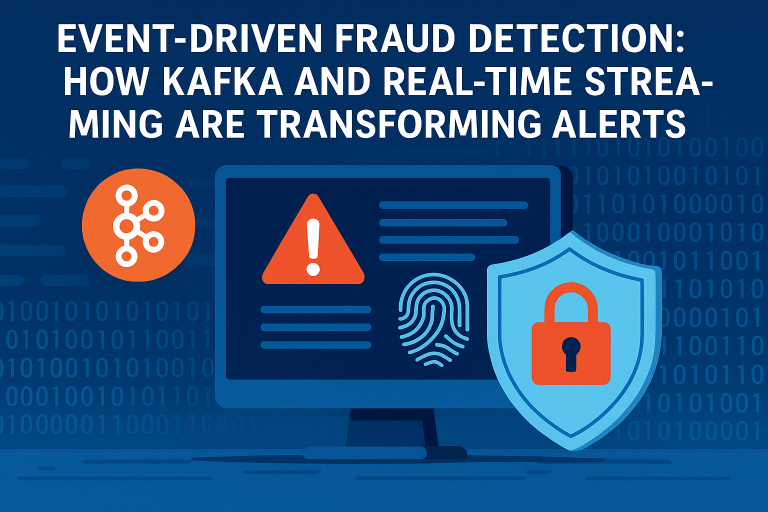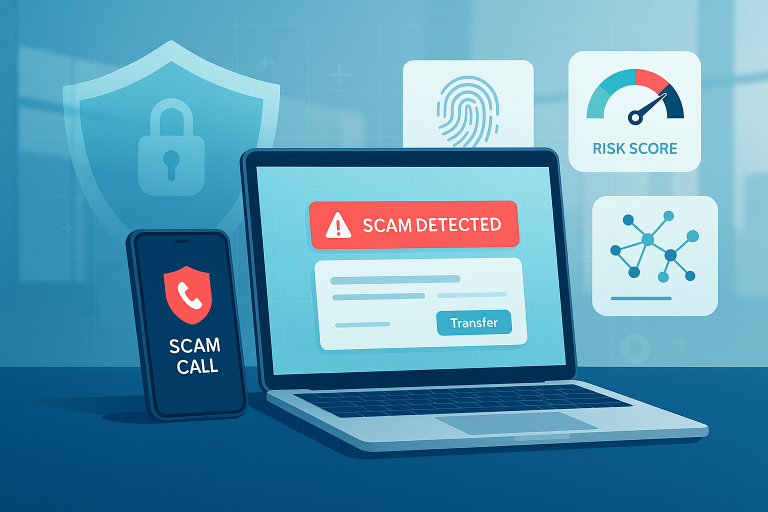Introduction: Why AI in Fraud Detection Matters
Fraud in the U.S. continues to surge. In 2024, consumers reported $12.5 billion in losses to the FTC, while the FBI’s IC3 report tallied $16.6 billion in cyber-enabled crimes.
For U.S. financial institutions, every $1 of fraud can cost $4.41 when labor, chargebacks, and compliance efforts are counted. That’s why AI in fraud detection is now table stakes across banking products and rails.
Related reading (internal): Bank Scam Prevention: What You Need to Know
The U.S. Fraud Landscape
Common Fraud Types
- Account takeover (ATO) & authorized push payment (APP) scams across Zelle, RTP, and FedNow.
- Synthetic identity fraud in credit, DDA onboarding, and BNPL (see the Federal Reserve’s overview of fraud topics here).
- Check fraud resurgence tied to mail theft (see the U.S. Postal Inspection Service).
- BEC & phishing campaigns targeting businesses (see FBI BEC guidance here).
Key U.S. Rules & Frameworks to Align With
- Regulation E → 10-day provisional credit / 45-day resolution timelines for EFT disputes.
- SR 11-7 → Model Risk Management for AI/ML models (development, validation, monitoring).
- NIST AI RMF 1.0 → Trustworthy AI risk management (bias, transparency, security).
- NACHA Account Validation → WEB debit account validation for first-use payments.
- FedNow Operating Procedures → participant risk tools (limits, monitoring, queries).
How U.S. Institutions Are Deploying AI
Network & Vendor AI
- Visa Advanced Authorization issues risk scores at authorization to reduce fraud and false declines.
- FICO Falcon uses consortium data across thousands of issuers for cross-channel detection.
- Zelle / Early Warning provides real-time risk screening signals for P2P payments.
Instant Payment Controls
For RTP and FedNow, banks combine transaction limits, first-time payee friction, off-hours controls, and scam classification based on the Federal Reserve’s ScamClassifier.
Real-World Examples from U.S. Banks
- JPMorgan Chase reports broad use of AI and machine learning in fraud monitoring across cards and payments (see Annual Report and technology strategy statements).
- Bank of America integrates AI within its Erica digital assistant to alert customers about potential suspicious activity (see Bank of America Newsroom).
- Wells Fargo references AI-enhanced monitoring of digital payments, including P2P fraud controls (see Wells Fargo Newsroom).
Note: Treat vendor and public claims as directional. Validate with your own controlled A/B tests and champion/challenger models.
Models Driving AI in Fraud Detection
- Supervised ML (e.g., gradient boosting, XGBoost) for known fraud patterns in cards/ACH.
- Graph analytics (entity resolution, community detection) for mule rings and synthetic IDs.
- Behavioral biometrics for ATO—align with FFIEC guidance.
- NLP & Generative AI for dispute triage, claim summarization, and SAR drafting (human-in-the-loop).
Academic support:
IEEE Access: Machine Learning Methods for Credit Card Fraud Detection (2024)
Systematic Review of Credit Card Cyber Fraud Detection (2023, PMC)
Analyst Workflow: From Alerts to Outcomes
1) Ingest & Score
Stream transactions from card auth, ACH, wires, RTP/FedNow, and online banking. Score with models that produce a risk probability (0–1) and key features for explainability.
2) Alert Generation & Routing
- Auto-action: very high risk + explainable alerts (e.g., known mule hub) → block or hold.
- Manual review: medium-risk alerts → analyst queue with evidence pack.
- Education: “are-you-sure” interstitials for suspected scams on instant rails.
3) Investigation
Provide analysts a 360° case view: account history, device and IP graph, payee risk, velocity, prior claims, customer segment, and Reg E clock status.
4) Resolution & Feedback Loop
Capture final disposition (confirmed fraud, customer error, first-party abuse). Feed labels and analyst notes back into the feature store for retraining and policy tuning.
Dashboards Analysts Should Build
Reg E Claims Command Center
- KPIs: % provisionally credited within 10 business days; average investigation time; Day-45 compliance; reopen rate; CFPB escalation rate.
- Why it matters: Directly maps to Regulation E timelines and exam expectations.
Instant Payments Risk (RTP/FedNow)
- KPIs: send/receive velocity; first-time payee risk; reversal/return attempts; off-hours spikes; mule score distribution.
- Align with: FedNow participant tools and rules.
Synthetic Identity & Mule Risk
- Views: community graphs, shared identifiers (devices, phones, addresses), rapid account churn, thin-file anomalies.
Elder Fraud & BEC Lens
- KPIs: 60+ segment losses, BEC attempt volume, new email domains, recipient account age.
- Anchor to: FBI/IC3 trends here.
Model Risk & Drift Monitor
- Metrics: PSI/CSI population stability, AUC/KS, precision/recall by segment, latency and uptime SLAs, SHAP top features drift.
- Governance: Publish in SR 11-7 monitoring packs; map to NIST AI RMF.
Example Analyst Artifacts (Reports & Snippets)
1) Monthly Fraud Loss Report (Executive)
- Losses by product/rail (card, ACH, wires, RTP/FedNow, Zelle).
- Fraud basis points (bp) vs. volume growth; false-positive rate; customer friction rate (declines/step-ups).
- Losses avoided attributed to network scores/models; Reg E Day-10/Day-45 compliance.
2) Risk Threshold Tuning Memo
- Pre/post threshold impact: capture rate, FPR, manual review rate.
- Confidence intervals and business cost model (fraud loss vs. friction cost).
3) Example SQL (feature sanity check)
-- First-time payee flag (RTP/FedNow)
SELECT txn_id,
acct_id,
payee_id,
CASE WHEN MIN(txn_ts) OVER (PARTITION BY acct_id, payee_id) = txn_ts THEN 1 ELSE 0 END AS is_first_payee_txn
FROM instant_payments_txns;4) Example SQL (velocity feature)
-- 24h send velocity by account
SELECT acct_id,
COUNT(*) FILTER (WHERE txn_ts >= NOW() - INTERVAL '24 HOURS') AS sends_24h,
SUM(amount) FILTER (WHERE txn_ts >= NOW() - INTERVAL '24 HOURS') AS send_amt_24h
FROM instant_payments_txns
GROUP BY acct_id;Related reading (internal): Synthetic Identity Fraud: The Growing Threat
Build vs. Buy
- Buy: network/consortium intelligence you can’t replicate in-house (e.g., Visa risk scores, FICO Falcon, Zelle/Early Warning).
- Build: your feature store, graph pipeline, and case/claims data hub (institutional IP).
- Integrate: FedNow/RTP rulebooks and tools into your operational dashboards.
Compliance & Governance Essentials
- Maintain a model inventory with risk tiering; document data lineage and feature dictionaries.
- Independent validation (conceptual soundness, outcomes analysis, monitoring & change management) per SR 11-7.
- Bias/fairness checks, transparency logs, and incident response mapped to NIST AI RMF.
90-Day Implementation Blueprint
First Weeks 1–3: Foundations
- Stand up a fraud feature store (customer, device, graph, payment features) with 18–24 months of backfill.
- Launch the Reg E dashboard; measure Day-10/Day-45 compliance from day one (Reg E).
Next Weeks 4–7: Pilot & Prove
- Pilot a scam classifier for instant payments with step-up flows; include first-use payee friction (see ScamClassifier).
- Integrate card network authorization scores; run A/B tests to quantify false-decline reduction.
Weeks 8–12: Scale & Govern
- Roll out graph-based mule detection with an analyst graph explorer and SAR workflow.
- Publish SR 11-7 validation pack; operationalize NIST AI RMF controls and monitoring KRIs.
Key Metrics for Executives
- Fraud loss basis points (by rail/product) and trend vs. volume growth.
- False-positive and customer friction rates (declines, step-ups).
- Scam containment: % stopped pre-send; % recovered post-send.
- Reg E compliance (Day-10 & Day-45 on EFT disputes).
- Losses avoided attributed to AI in fraud detection and network scores.
Conclusion: The Future of AI in Fraud Detection
For U.S. banks, AI in fraud detection is essential. The leaders blend network intelligence with proprietary features, graph analytics, and strong governance. Analysts accelerate the journey by building the right dashboards, tuning thresholds with disciplined A/Bs, and closing the loop from investigation outcomes back into models.
Focus keyphrase: AI in fraud detection
References & Further Reading
- FTC: 2024 consumer fraud losses
- FBI IC3: 2024 Internet Crime Report
- LexisNexis: True Cost of Fraud Study
- Federal Reserve: SR 11-7 Model Risk Management
- NIST: AI Risk Management Framework 1.0
- NACHA: Account Validation Rule
- FedNow: Operating Procedures & resources
- Visa: Advanced Authorization
- FICO: Falcon Fraud Manager
- Early Warning/Zelle: Risk & payments
- Academic (2024): IEEE Access survey on ML for card fraud
- Academic (2023): Systematic review of cyber fraud detection (PMC)








